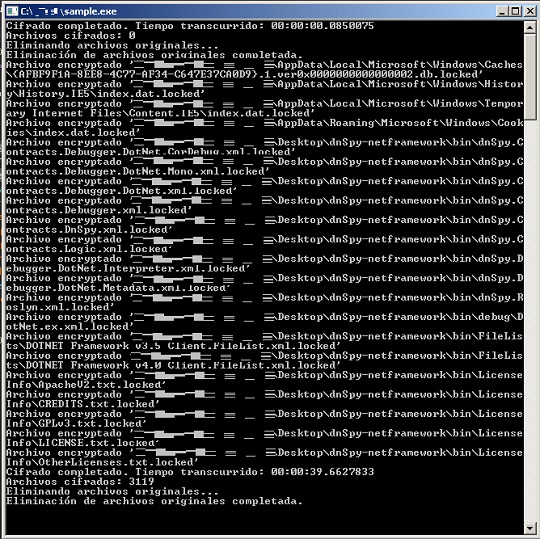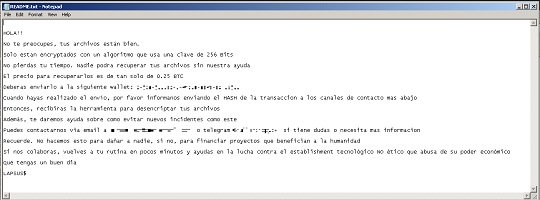Ransom.MSIL.LAPSUS.THKAFBC
Win32:RansomX-gen [Ransom] (AVAST)
Windows


Threat Type: Ransomware
Destructiveness: No
Encrypted: No
In the wild: Yes
OVERVIEW
Downloaded from the Internet, Dropped by other malware
This Ransomware arrives on a system as a file dropped by other malware or as a file downloaded unknowingly by users when visiting malicious sites.
It encrypts files with specific file extensions. It drops files as ransom note.
TECHNICAL DETAILS
13,312 bytes
EXE
No
15 Nov 2023
Encrypts files, Displays windows
Arrival Details
This Ransomware arrives on a system as a file dropped by other malware or as a file downloaded unknowingly by users when visiting malicious sites.
Other Details
This Ransomware does the following:
- It displays its execution log and encryption progress in console.

- It avoids encrypting files in the CD-ROM.
Ransomware Routine
This Ransomware encrypts files with the following extensions:
- .7z
- .bak
- .conf
- .csv
- .dat
- .db
- .dbf
- .doc
- .docx
- .dwg
- .eml
- .fbk
- .FBK
- .fdb
- .FDB
- .flv
- .frm
- .gif
- .html
- .ibd
- .jpeg
- .jpg
- .json
- .kdb
- .kdbx
- .ldb
- .ldf
- .LDF
- .mai
- .mdb
- .mdf
- .MDF
- .msg
- .odp
- .ods
- .odt
- .ogg
- .opt
- .png
- .ppt
- .pptx
- .pst
- .rar
- .rtf
- .sql
- .sqlite
- .tar
- .tsv
- .txt
- .vb
- .wab
- .xls
- .xlsx
- .xml
- .xml
- .zip
It avoids encrypting files with the following strings in their file path:
- Windows
- System Volumen Information
It appends the following extension to the file name of the encrypted files:
- .locked
It drops the following file(s) as ransom note:
- {Encrypted Directory}\README.txt

SOLUTION
9.800
18.822.01
15 Nov 2023
18.823.00
16 Nov 2023
Step 1
Before doing any scans, Windows 7, Windows 8, Windows 8.1, and Windows 10 users must disable System Restore to allow full scanning of their computers.
Step 2
Note that not all files, folders, and registry keys and entries are installed on your computer during this malware's/spyware's/grayware's execution. This may be due to incomplete installation or other operating system conditions. If you do not find the same files/folders/registry information, please proceed to the next step.
Step 3
Search and delete this file
- {Encrypted Directory}\README.txt
Step 4
Scan your computer with your Trend Micro product to delete files detected as Ransom.MSIL.LAPSUS.THKAFBC. If the detected files have already been cleaned, deleted, or quarantined by your Trend Micro product, no further step is required. You may opt to simply delete the quarantined files. Please check the following Trend Micro Support pages for more information:
Step 5
Restore encrypted files from backup.
Did this description help? Tell us how we did.

